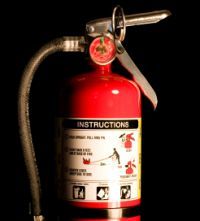

With some significant upcoming regulatory changes on the way which will affect foam fire extinguishers across the UK, we take a Barbour-style look at what a move away from certain foams will mean for you!
This is part of an ongoing phase-out of perfluorooctanoic acid (PFOA) from firefighting products due to the lasting harmful impact on the environment.
Current situation
The UK Government is continuing to meet its commitment to phase out the use of PFOAs from firefighting products.
PFOAs are known as "forever chemicals" due to the lasting harmful impact on the environment.
This phase out is being done through measures restricting or prohibiting the manufacturing, placing on the market and use of PFOA, its salts and PFOA-related compounds used in fire-fighting foam for liquid fuel vapour suppression and Class B fires.
It will include the use of aqueous film forming foams (AFFF) fire extinguishers.
What are "forever chemicals"?
"Forever chemicals" have been widely used across the world since the 1940s, from fire-fighting foams to industrial applications and consumer products. Their high thermal and chemical stability and water and oil-repellent nature means they have been heavily used in cosmetics, coatings for textiles and paper including food contact materials.
They comprise per and polyfluoroalkyl substances (PFAS) which is the collective name given to a group of fluorinated compounds.
PFAS are everywhere in nature due to their inability to break down. The long history of their use has resulted in "a legacy of environmental contamination that is challenging to remediate", according to the Environment Agency, and their toxic nature has been linked to health problems since the 1990s. They are a large group of synthetic, environmentally persistent and potentially toxic chemicals, which can build up in living organisms through a process called bioaccumulation.
The best known examples of PFAS are PFOAs and perfluorooctane sulfonate (PFOS), both of which are now subject to regulatory restrictions because of their harmful properties.
What's the legislation I need to look at?
Assimilated Regulation 2019/1021 on persistent organic pollutants (the UK POPs Regulation) bans the production, placing on the market and use of substances, mixtures and articles containing PFOA, its salts and PFOA-related compounds.
They have previously been used as active ingredients in Class B firefighting foams, and particularly so within AFFFs, in the main due to their surfactant properties. They may also be present in foams as a contaminant.
The situation in Northern Ireland is slightly different. Since 1 January 2021, Northern Ireland has continued to implement Regulation (EU) 2019/1021 on persistent organic pollutants (the EU POPs Regulation) as a result of the Northern Ireland Protocol.
Exemptions and deadlines
There was a recent restriction from 1 January 2023, where the use of the fire-fighting foam is only allowed in sites where all releases can be contained - essentially, where the foam cannot be contained or collected after a fire has been extinguished.
However, there is an exemption that is soon coming to an end. Annex 1 in the UK POPs Regulation currently exempts the use of PFOA, its salts and PFOA-related compounds in firefighting foams for Class B fires already installed in systems, including both mobile and fixed systems.
This exemption will end on 4 July 2025.
Aren't these chemicals linked to REACH as well?
They are!
They were mentioned in a Government document that prioritises substances for UK REACH – specifically PFAS in fire fighting foams, so there’s a chance there could be some future restrictions under UK REACH legislation too.
If there’s any chemicals that are affected, they’ll get added to Annex 17, which is the list of chemicals with restrictions around their manufacture, marketing and use.
In fact, a Health and Safety Executive (HSE) consultation ended in June 2024, that aimed to gather information and evidence relating to firefighting foams which contain PFAS.
In Europe, the focus has turned to another PFAS compound, PFHxA, which has now been restricted under the EU’s REACH Regulation. It will be interesting to see if the UK follows this path.
What do I need to do?
It would be a good idea for you to get a head start on the upcoming changes.
Assess your current fire safety equipment and plan for the switch to safer alternatives. It is essential that you find out whether the foam in your extinguishers contains PFOA, its salts and/or PFOA-related compounds.
You can do this by:
If your fire extinguishers have been regularly serviced, refilled or replaced every five years, its likely they do not contain PFOS or PFOA.
However, if your extinguishers are very old with no service or refill record, then it should be assumed to be potentially containing PFOS or PFOA and environmentally disposed of.
In addition, if you intend to use, or have a stockpile of Class B foam already installed in systems which contains or may contain PFOA, its salts and/or PFOA-related compounds, you must comply with the following conditions: